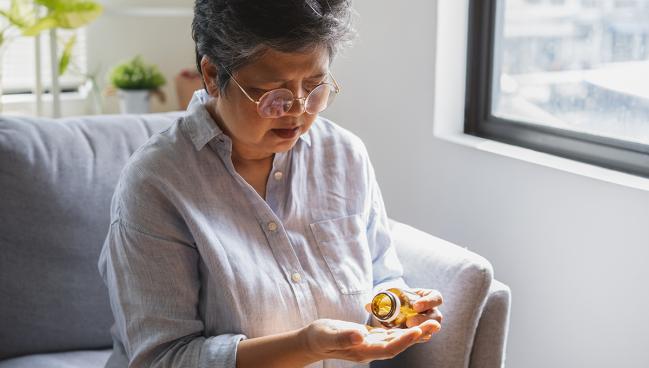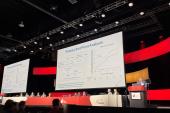Vascular Disease History Need Not Preclude Aspirin Withdrawal After HeartMate 3
The ARIES-HM3 substudy may help persuade implanters who are less well-versed in the circulatory changes an LVAD affords.

Patients with preexisting indications for aspirin therapy—including those with a history of revascularization, stroke, or peripheral vascular disease—may not need the drug after receiving the HeartMate 3 (Abbott) left ventricular assist device (LVAD), according to new data from the ARIES-HM3 trial.
The findings are in line with the main results released in 2023 showing that not only does an aspirin-free regimen, compared with low-dose aspirin plus vitamin K antagonist therapy, lead to fewer bleeding events but also there is no associated increased risk of stroke or other thromboembolic events at 12 months. Notably, the results of ARIES-HM3 led the US Food and Drug Administration to approve a label change for the LVAD removing the requirement for postimplant aspirin.
While some investigators initially argued this subgroup of patients should be excluded from the trial, Mandeep Mehra, MD (Brigham and Women’s Hospital, Boston, MA), who presented the original findings and served as senior author on the new paper, pushed for their inclusion. “The minute you put in an LVAD, the circulatory conditions change completely so that any prior information on the utility of antiplatelet therapy with these preexisting conditions is no longer valid,” he explained.
After implantation, the LVAD can cause both a deficit of von Willebrand factor as well as a risk of arteriovenous malformations in the gut, according to Mehra. “We argued that because there is already an increased propensity for bleeding in these patients, that the addition of an antiplatelet, even in those patient groups that previously would be served with antiplatelets, was no longer feasible or necessary and particularly since we use background vitamin K antagonist therapy,” he said.
The minute you put in an LVAD, the circulatory conditions change completely so that any prior information on the utility of antiplatelet therapy with these preexisting conditions is no longer valid. Mandeep Mehra
Ultimately, 41% of patients from the main trial were eligible for inclusion in this substudy, and “this actually gave us robustness to test the generalizability even for those populations,” Mehra continued. “We were very pleased to report that, in fact, the primary findings of the trial are well preserved in the secondary analysis that was prespecified.”
While some centers have become more aggressive with removing aspirin from the post- HeartMate 3 implant treatment plan, others have been less reluctant to do so.
“As we look at quality and we look at outcomes, this will help centers that are still giving aspirin in that population to feel more comfortable with the safety of aspirin withdrawal,” Jennifer Cowger, MD (Henry Ford Hospital, Detroit, MI), who was not involved in the substudy, commented to TCTMD.
Similarly, Palak Shah, MD (Inova Schar Heart and Vascular and George Washington University, Falls Church, VA), told TCTMD his center decided to stop using aspirin following HeartMate 3 implantations even before the FDA approved the label change.
“We're a relatively aggressive center, especially when it comes to anti-drug practices,” he said. “I think for other centers who have been deliberating how to uptake the clinical practice or are kind of saying, ‘Well, which patients should we potentially exclude from this practice?’ I think this analysis gives additional light to which patient populations they should think a little bit more carefully about before they withdraw.”
No Interaction Found
For the study, published online last week in JAMA Cardiology, Finn Gustafsson, MD, PhD (University of Copenhagen, Denmark), Mehra, and colleagues looked at the 240 patients from the main trial’s 589 with a history of PCI, CABG, stroke, or peripheral vascular disease. This cohort was older than those without a history of systemic vascular disease (mean age 61.7 vs 53.9 years) and more likely to have a prior sternotomy, history of bleeding, diabetes, and AF.
The researchers found no interaction between any of the included conditions and the effect of aspirin compared with placebo on the primary endpoint—a composite of survival free of nonsurgical major hemocompatibility-related adverse events including stroke, pump thrombosis, major nonsurgical bleeding, and arterial peripheral thromboembolism at 12 months (P for interaction = 0.23). Thus, the noninferiority margin of 10% was not crossed in this substudy.
Thrombotic events were rare in both patient populations with no difference between the study arms (P for interaction = 0.77). Nonsurgical major bleeding events, on the other hand, were less common with placebo than aspirin in patients with PCI, CABG, stroke, or peripheral vascular disease (rate ratio 0.52; 95% CI 0.35-0.79). This difference was attenuated in the population of patients without these histories (rate ratio 0.76; 95% CI 0.54-1.06).
This will help centers that are still giving aspirin in that population to feel more comfortable with the safety of aspirin withdrawal. Jennifer Cowger
“What was surprising with our study is that we did not actually see a contraction of the efficacy signal in these patients,” Mehra said. “If anything, we actually saw an expansion of the efficacy signal, indicating that in fact, in these patients, the effect size was not only preserved, but in many cases was more amplified compared to the overall trial findings.”
Notably, he said, the ARIES-HM3 data do not provide information on whether aspirin should be used in the not insignificant proportion of the LVAD population who were excluded from the trial, including those scheduled to receive a right ventricular assist device, as well as those who have been required to take aspirin.
“The third group of patients in whom I personally as a clinician might have some trepidation in removing antiplatelets completely are those who may have had a drug-eluting stent placed in a coronary circulation within, say 3, months before implantation of an LVAD, particularly in the right-sided circulation,” Mehra continued. “And the reason for that is that when we place an LVAD, the right ventricle remains unsupported, and if the right coronary artery then is somehow hampered in terms of its ability to nourish the right ventricle, then we may create a problem. However, this is speculative.”
Other ongoing subanalyses from the trial, including in patients who had concomitant surgical procedures as well as those with obesity, atrial fibrillation, and diabetes, will likely inform this space further, according to Mehra.
Unanswered Questions
In an accompanying editorial, Nosheen Reza, MD (Perelman School of Medicine at the University of Pennsylvania, Philadelphia), writes that what to do with patients who have required aspirin therapy remains an unanswered question.
“Preexisting atherosclerotic disease is the most common reason for antiplatelet therapy in an end-stage heart failure population, so it would be helpful for clinicians to better understand the characteristics of patients deemed to require aspirin,” she says. “It is possible that these patients are at a higher bleeding risk with aspirin therapy because of the sum of their comorbidities, suggesting that more nuanced phenotyping of vascular risk factors may better identify those who benefit most.”
Though these patients represent about one-fifth of LVAD patients, they are a small cohort more generally, and as such, it’s unlikely future clinical trials will study them specifically, Shah said. However, he added, “I do think perhaps there will be additional substudies that come out that give some additional information and granularity to clarify who those patients were.”
I think this analysis gives additional light to which patient populations they should think a little bit more carefully about before they withdraw. Palak Shah
For now, he said his institution plans to continue withdrawing aspirin in patients receiving HM3 devices, save for those who had a recent PCI, significant PAD, stroke, or CABG. “There still needs to be some thought and deliberation about whether or not this patient that you're managing at your center is truly an ARIES-HeartMate 3 trial-eligible patient,” Shah added.
Cowger, for her part, plans to continue stopping aspirin “routinely in all of our patients, unless you have a mechanical mitral valve.” But she said she’ll continue to question what to do for the occasional patient with recent coronary, vascular surgery, and lower-extremity vascular interventions. “There is great divergence of opinion and practice within and between centers on how to handle antiplatelet therapy (aspirin or Plavix) in persons on HeartMate 3 with fresh stents that have not had time to endothelialize," she said.
“What this study isn't dividing out is the time frame from intervention, meaning: what is the time frame for PCI and aspirin withdrawal that makes it safe to be comfortable?” Cowger continued. “That is a remaining question when I look at this.”
More to Study
Going forward, Shah said the most exciting research in this space will involve using direct oral anticoagulants (DOACs) for LVAD patients, as his team recently presented in a small feasibility study.
“We really don't have enough data to recommend that DOACs should be used,” Mehra said. “And in fact, there are some significant concerns with DOACs, particularly with bridge-to-transplant patients on an LVAD, because these patients tend to have a lot of bleeding complications with the dissection of the LVAD.”
A novel vitamin K antagonist called tecarfarin (Cadrenal Therapeutics) might work for these patients, he added, and a study is in the planning stages to compare it against warfarin in aspirin-naive LVAD patients. “The other question is whether the novel anticoagulants such as factor XI inhibitors might be ripe for testing in this scenario,” Mehra continued.
“So I think the future is quite bright, and there needs to be more study in this space to decrease the residual risk,” he concluded. “Because one of the things that ARIES also showed is that even though we show a nearly 40% reduction in bleeding with just the simple removal of aspirin by 2 years, even aspirin-naive patients still have a substantial risk of bleeding of almost 30%. That residual risk needs to be addressed even further.”
Yael L. Maxwell is Senior Medical Journalist for TCTMD and Section Editor of TCTMD's Fellows Forum. She served as the inaugural…
Read Full BioSources
Gustafsson F, Uriel N, Netuka I, et al. Aspirin and hemocompatibility after LVAD implantation in patients with atherosclerotic vascular disease. JAMA Cardiol. 2025;Epub ahead of print.
Reza N. Omitting aspirin in high-risk left ventricular assist device implant. JAMA Cardiol. 2025;Epub ahead of print.
Disclosures
- Reza reports receiving personal fees from American Regent, AstraZeneca, Bristol Myers Squibb, Idorsia, Novo Nordisk, Roche, and Zoll and grants from Bristol Myers Squibb and the National Heart, Lung, and Blood Institute of the US National Institutes of Health.
- Shah reports receiving research support from Abbott.
- Cowger reports consulting for Abbott and serving as an investigator in the original ARIES-HM3 trial.





Comments